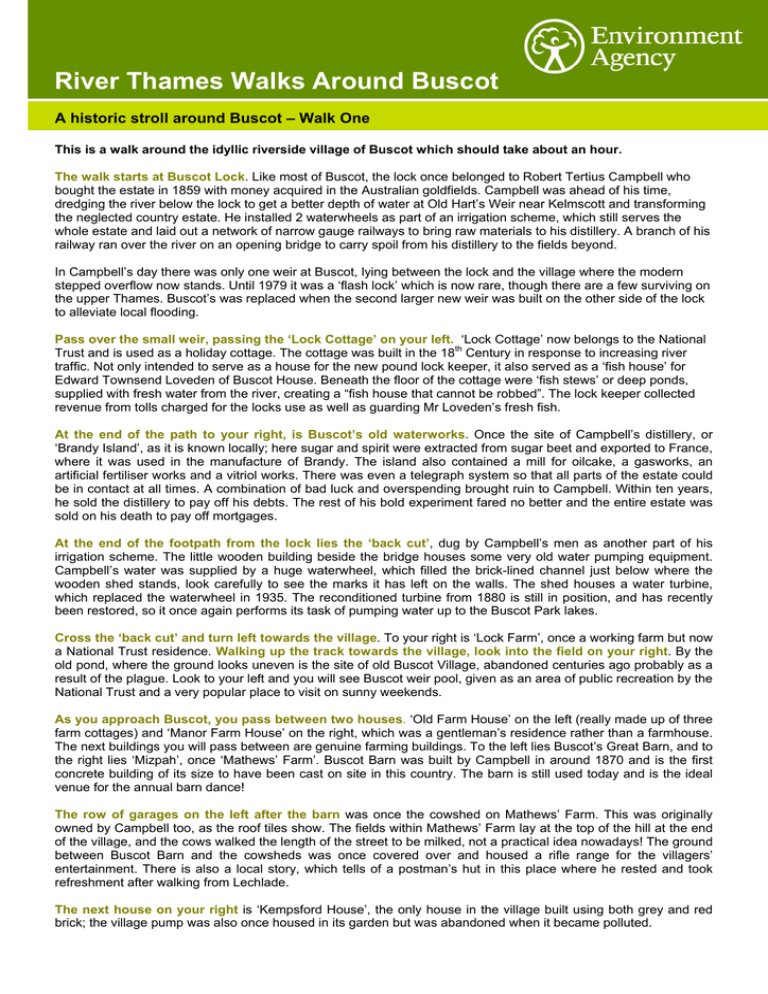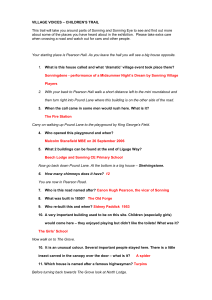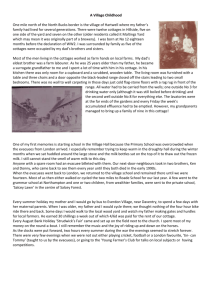A historic walk around Buscot
advertisement

River Thames Walks Around Buscot A historic stroll around Buscot – Walk One This is a walk around the idyllic riverside village of Buscot which should take about an hour. The walk starts at Buscot Lock. Like most of Buscot, the lock once belonged to Robert Tertius Campbell who bought the estate in 1859 with money acquired in the Australian goldfields. Campbell was ahead of his time, dredging the river below the lock to get a better depth of water at Old Hart’s Weir near Kelmscott and transforming the neglected country estate. He installed 2 waterwheels as part of an irrigation scheme, which still serves the whole estate and laid out a network of narrow gauge railways to bring raw materials to his distillery. A branch of his railway ran over the river on an opening bridge to carry spoil from his distillery to the fields beyond. In Campbell’s day there was only one weir at Buscot, lying between the lock and the village where the modern stepped overflow now stands. Until 1979 it was a ‘flash lock’ which is now rare, though there are a few surviving on the upper Thames. Buscot’s was replaced when the second larger new weir was built on the other side of the lock to alleviate local flooding. Pass over the small weir, passing the ‘Lock Cottage’ on your left. ‘Lock Cottage’ now belongs to the National Trust and is used as a holiday cottage. The cottage was built in the 18th Century in response to increasing river traffic. Not only intended to serve as a house for the new pound lock keeper, it also served as a ‘fish house’ for Edward Townsend Loveden of Buscot House. Beneath the floor of the cottage were ‘fish stews’ or deep ponds, supplied with fresh water from the river, creating a “fish house that cannot be robbed”. The lock keeper collected revenue from tolls charged for the locks use as well as guarding Mr Loveden’s fresh fish. At the end of the path to your right, is Buscot’s old waterworks. Once the site of Campbell’s distillery, or ‘Brandy Island’, as it is known locally; here sugar and spirit were extracted from sugar beet and exported to France, where it was used in the manufacture of Brandy. The island also contained a mill for oilcake, a gasworks, an artificial fertiliser works and a vitriol works. There was even a telegraph system so that all parts of the estate could be in contact at all times. A combination of bad luck and overspending brought ruin to Campbell. Within ten years, he sold the distillery to pay off his debts. The rest of his bold experiment fared no better and the entire estate was sold on his death to pay off mortgages. At the end of the footpath from the lock lies the ‘back cut’, dug by Campbell’s men as another part of his irrigation scheme. The little wooden building beside the bridge houses some very old water pumping equipment. Campbell’s water was supplied by a huge waterwheel, which filled the brick-lined channel just below where the wooden shed stands, look carefully to see the marks it has left on the walls. The shed houses a water turbine, which replaced the waterwheel in 1935. The reconditioned turbine from 1880 is still in position, and has recently been restored, so it once again performs its task of pumping water up to the Buscot Park lakes. Cross the ‘back cut’ and turn left towards the village. To your right is ‘Lock Farm’, once a working farm but now a National Trust residence. Walking up the track towards the village, look into the field on your right. By the old pond, where the ground looks uneven is the site of old Buscot Village, abandoned centuries ago probably as a result of the plague. Look to your left and you will see Buscot weir pool, given as an area of public recreation by the National Trust and a very popular place to visit on sunny weekends. As you approach Buscot, you pass between two houses. ‘Old Farm House’ on the left (really made up of three farm cottages) and ‘Manor Farm House’ on the right, which was a gentleman’s residence rather than a farmhouse. The next buildings you will pass between are genuine farming buildings. To the left lies Buscot’s Great Barn, and to the right lies ‘Mizpah’, once ‘Mathews’ Farm’. Buscot Barn was built by Campbell in around 1870 and is the first concrete building of its size to have been cast on site in this country. The barn is still used today and is the ideal venue for the annual barn dance! The row of garages on the left after the barn was once the cowshed on Mathews’ Farm. This was originally owned by Campbell too, as the roof tiles show. The fields within Mathews’ Farm lay at the top of the hill at the end of the village, and the cows walked the length of the street to be milked, not a practical idea nowadays! The ground between Buscot Barn and the cowsheds was once covered over and housed a rifle range for the villagers’ entertainment. There is also a local story, which tells of a postman’s hut in this place where he rested and took refreshment after walking from Lechlade. The next house on your right is ‘Kempsford House’, the only house in the village built using both grey and red brick; the village pump was also once housed in its garden but was abandoned when it became polluted. A little further up the street to the left lie ‘Grey Tiles’ and ‘Grey Stones’, once several cottages in a row and now two. ‘Grey Stones’ was once a blacksmith’s shop – perhaps the iron gates and railings that adorn its garden were his own work? The village shop and the tiny cottage opposite are almost the last outposts of red brick in the village. All the cottages near the main road, the village hall and the tap which replaced the old pump were built at the same time by Mr Henderson, the first Lord Farringdon, who took over the estate after Campbell’s death and tried to revive Buscot’s prosperity. He did not succeed and his family in turn sold the estate, this time to a relative of Thames Cook the travel agent. The Cook family gave Buscot Park and its grounds to the National Trust at the time of purchase, and the rest of the village passed into the same hands when Mr Cook died in the mid 1960’s. At the end of the village street, turn right; but before you do, look at the curious building which almost leans out of the garden of the last house on the right, this is the ‘Death House’. Originally a waiting room for passengers of the London to Cheltenham coach but more recently used as a temporary mortuary for any sudden deaths in the parish. Further down the road is Apple Tree House, which is now a B&B expanded from small beginnings by Campbell, who used it to house his navvies while they dug his reservoirs and built the factories on Brandy Island. He renamed it the Campbell Arms, much to local disgust and after his death it quickly became the Red Lion, remaining the same until the owners renamed it The Apple Tree Inn after the tree in its garden. The tree, blown down in the gales of 1989, continues to flower and flourish from a horizontal position to this day! Apple Tree House, the new lock house and the waterworks are the only buildings in the village not owned by the National Trust. Opposite Apple Tree House, next to a pair of cottages, you will see the ‘Old Forge’ which replaced ‘Grey Stones’ as the village blacksmith’s shop. Mr Bartlett worked here until the late 1960’s, while his wife ran the village shop. The forge is now in use again, producing fine quality wrought iron work. The next house you pass, as you continue along the main road, is Alma Cottage, which was formally the village policeman’s house. The garden on the side of the first house you come to, was once the village pound where stray animals were penned until their owners claimed them and paid a fine. The house gets its name from the Christian names of its first inhabitants – Alan and Margery. The following group of houses is known as ‘The Dab’. A rather mysterious hotchpotch of buildings, the central house would appear to date from Campbell’s time, judging from the tiles on the roof; but the remaining buildings have been randomly added. Anyone from Buscot will tell you that it gets its name from being ‘just dabbed together’. The next house, squeezed into the side of another large group of cottages, is ‘Church Cottage’. Built by Lord Faringdon for the verger of St Mary’s church, the cottage is still in use today. Next door to Church Cottage are ‘The Malthouses’, built by Campbell to house his skilled French workers. In the central block, behind cast metal windows, lie huge rooms once used as dormitories. Opposite ‘The Malthouses’ is the site of the old village school. It was closed about 35 years ago, when the schoolteacher moved out and the highways authority bought it in order to widen the road. The building was swiftly demolished, but the road has yet to be widened! Take the next turning to the right, signposted ‘Buscot Church’. The footpath follows the drive to old Buscot Rectory, a fine Georgian building which was sold by the church to an American author, whose companion, Mr Mussett, designed and sold statues. If walking along the riverbank between Buscot and Lechlade, glance across to the grounds of rectory where you will see some of his work. The house was left to the National Trust on the author’s death, with the condition that any tenants should have American literary connections. Buscot Church stands on a piece of ground which has housed a place of worship since the 13th century. The church contains a stunning set of Burne Jones stained glass windows, a zigzag carved chancel arch, an ancient font, a Tudor arched porch, and several monuments of the Loveden family. If it is open, go and rest there for a while. The churchyard contains more fine monuments; but you will not find the grave of Robert Tertius Campbell as he chose to be buried at Eaton Hastings. When you leave the churchyard you may wonder why the lovely lych gate decorates the back entrance of the church. If you look at the dates on the headstones on either side of the path you’ll get a clue; the churchyard was expanded in the 1930s. When the lych gate was installed, celebrating Queen Victoria’s Diamond Jubilee, the only public entrance was at this end of the churchyard. The vicar had his own private entrance to the churchyard itself, a small iron gate in the churchyard wall that can still be seen; it was also used only by the incumbent and favoured members of the local gentry. The rest of the congregation would have walked from the village, using the footpath you now take to complete your walk. Take the path through the field outside the lych gate, and pass beside the gardens of Lock Farm to return to your starting point at the lock.





